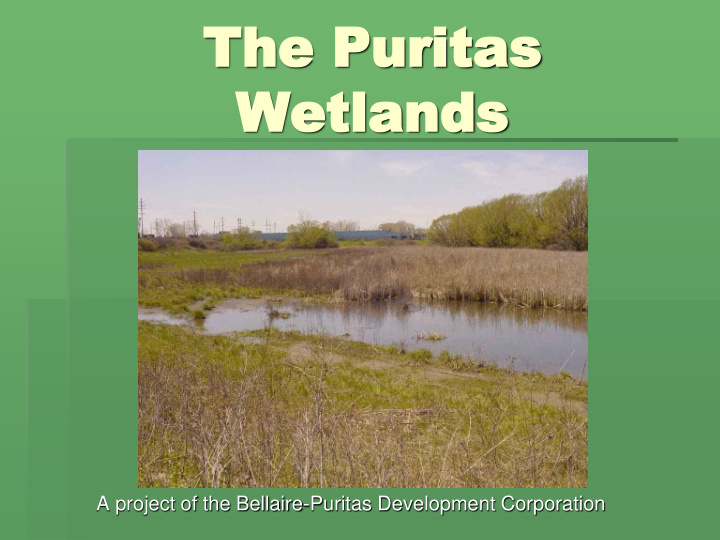



The Puritas The Puritas Wetlands Wetlands A project of the Bellaire-Puritas Development Corporation
What are the Puritas What are the Puritas Wetla Wetlands? nds? 80 acre-detention basin lying in the Big Creek watershed approximately two miles south of Lake Erie located in the heart of the City of Cleveland bordered by residential and light industrial properties Home to the American Agricultural Chemical Company until 1970, a commercial fertilizer plant Today, it is a man-made channel designed to direct stormwater runoff away from contiguous commercial, residential, and light industrial properties, as well as I- 480.
The Puritas The Puritas Wetlands Wetlands
The Puritas The Puritas Wetlands Wetlands Land Use Categories: Residential = Yellow Retail = Red Industrial = Blue
What What makes makes the the Puritas Puritas Wetlands Wetlands unique? unique? The Puritas Wetlands has a robust ecological character given its urban setting. Over 138 avian species have been catalogued at the site including the endangered Ohio yellow-bellied sapsucker, the olive-sided flycatcher, the American bittern and Wilson’s snipe. Over 66 plant species have been catalogued at the site including a county record for presence of sundrops and a rare occurrence of the whorled milkweed.
Yellow-bellied Sapsucker Kestrel Goldfinch
Wilson’s Snipe American Bittern
Whorled milkweed Sun drops Vervain
How How did did the the project project start? start? Bill Oatey, chairman of the local plumbing products manufacturer Oatey Co. that borders the Puritas wetlands, was the first to call attention to the wildlife activity at the site and engage the Wildlife Habitat Council. In 2005 the Cleveland Museum of Natural History surveyed and catalogued the bird and plant species in the basin. In early 2005 key partners met to begin planning efforts around enhancing and preserving the existing conditions in the basin, and to eventually offer passive learning and recreation opportunities at the site. In a November 2005 a public meeting was held to share our planning ideas with the community. We received full support for the project.
Who are Who are the key the key project project partn partners? ers? Bellaire-Puritas Development Corporation City of Cleveland Planning Department City of Cleveland Division of Water Pollution Control Cleveland Museum of Natural History Wildlife Habitat Council Cuyahoga River Remedial Action Plan
What have w What have we done so e done so far? far? We received a $10,000 grant from the National Fish and Wildlife Foundation. We attempted to spray targeted portions of the basin to control invasive plants, and free up greater growth of native, non- invasive species. On April 25, 2008 we held a spring planting day at the site.
Spring Spring 2008 P 2008 Planting Day lanting Day
The Puritas The Puritas Wetlands Wetlands Septe September mber 200 2008
What is What is next for the next for the Purit Puritas as Wetla Wetlands? nds? We are planning a second planting day. We are seeking additional funding for educational enhancements to the site such as interpretive signage and informational kiosks. We are looking for a location at the site to add the passive learning and recreation space.
What are our current What are our current cha challeng llenges? es? Location, location, location… The actual basin is owned by the City of Cleveland, and falls under the Division of Water Pollution Control, thus limiting individual access to the site for educational or recreational purposes. There is always the threat that publicly held land can be sold to private developers if proper measures are not taken to preserve the area. Access to the site is also limited because the land surrounding the basin is primarily private property owned by either residents or industries.
Thank You! Thank You! Olive-sided flycatcher
Recommend
More recommend